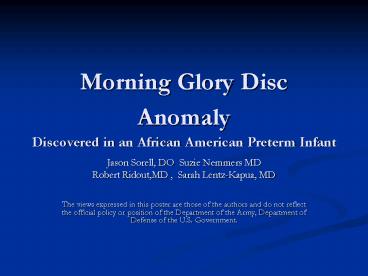Morning Glory Disc Anomaly Discovered in an African American Preterm Infant - PowerPoint PPT Presentation
1 / 12
Title:
Morning Glory Disc Anomaly Discovered in an African American Preterm Infant
Description:
The views expressed in this poster are those of the authors and do not reflect ... 4. Pollock S; The morning glory disc anomaly: contractile movement, ... – PowerPoint PPT presentation
Number of Views:137
Avg rating:3.0/5.0
Title: Morning Glory Disc Anomaly Discovered in an African American Preterm Infant
1
Morning Glory Disc Anomaly Discovered in an
African American Preterm Infant
- Jason Sorell, DO Suzie Nemmers MD
- Robert Ridout,MD , Sarah Lentz-Kapua, MD
- The views expressed in this poster are those of
the authors and do not reflect the official
policy or position of the Department of the Army,
Department of Defense of the U.S. Government.
2
Purpose/Objective
- To report a case of morning glory disc anomaly
(MGDA) in a premature African American male
infant
3
Background
- MGDA is a congenital abnormality, funnel-shaped
excavation of the posterior fundus that
incorporates the optic disk.5 - MGDA may result when incomplete neuroectodermal
development leads to an abnormal closure of the
embryonic fissure.
4
Methods
- Observational case study
- Literature Review
- History Ocular Exam
- Brain MRI/MRA
- AB-scan
OD
OS
OD
OS
5
Literature Review
- MGDA is rare in African Americans3,4 and more
common in females than males (21).3,4,5 - MGDA is almost always unilateral and typically
presents in early childhood as amblyopia and
strabismus.2,3,4,5 - Kushner successfully treated patients with
functional amblyopia secondary to structural
optic nerve abnormalities.6 - Non-rhegmatogenous retinal detachments reported
in 25-38 of MGDA5
6
Associated Systemic Anomalies1,5,11
- In a retrospective observational case series, 9
of 20 patients (45) with MGDA had identifiable
cerebrovascular anomalies .Three required
revascularization procedures and three were
diagnosed with Moyamoya disease.1
- Panhypopituitarism
- Basal encephalocele
- Absent corpus callosum
- cleft lip/palate, hypertelorism
7
Results
- A premature African American male born at 28
weeks gestation was found to have MGD of OD
stage 1 ROP, zone II in OU on fundus exam during
ROP screening. He also had microphthalmia of OD.
- Birth wt 1110g
- No craniofacial abnormalities
- VaRTL OU No RAPD
- Ttp17 OU
- External ocular exam anterior segment
unremarkable except cornea diameter of OD lt OS
(7x7mm 9.5x9.5mm respectively)
8
OD
9
OS
10
Results
- A-scan OD OS
- AxL 17.4 18.2mm
- B-scan possible excavation
- MRI no intracranial vascular anomaly
- Patent ductus arteriosus ligation
11
Conclusions
- MGDA can occur in African Americans.
- Children with MGDA should undergo MRI/MRA or CT
angiography to detect associated vascular and
structural brain anomalies.1 - A growth evaluation is recommended to detect
possible panhypopituitarism.11 - A trial of occlusion therapy for functional
amblyopia is warranted.5,6 - Closely follow for possible retinal
detachment.7,8,9,10
12
Bibliography
- 1. Lenhart P, Lambert S, Newman N, et al.
Intravascular anomalies in patients with morning
glory disc anomaly. Am J Ophthalmol. 2006
Oct142(4)644-50. - 2. Kindler P. Morning glory syndrome an unusual
optic disc anomaly. Am J Ophthalmol 1970 69376.
- 3. Steinkuller P. The morning glory disk
anomaly case report and literature review. J
Pediatr Ophthalmol Strabismus 1980 1781-87. - 4. Pollock S The morning glory disc anomaly
contractile movement, classification, and
embryogenesis. Doc Ophthalmol 1987 65439-460. - 5. Brodsky, MC. Congenital optic disk anomalies.
Surv of Ophthalmol 1994 3989-112. - 6. Kushner BJ Functional amblyopia associated
with abnormalities of the opitc nerve. Arch
Ophthalmol 102683-85, 1985 - 7. Haik BG, Greenstein SH, Smith ME, et al
Retinal detachment in the morning glory syndrome.
Ophthalmology 911638-47, 1984. - 8. Akiyama K, Azuma N, Hida T, Uemura Y. Retinal
detachment in morning glory syndrome. Ophthalmic
surgery. 1984 15 841-83. - 9. Chang S, et al. Treatment of total retinal
detachment in morning glory syndrome. Am J
Ophthalmol 1984 97596-600. - 10. Fricken, MA, Dhungel, R. Retinal detachment
in the morning glory syndrome. Retina 1984
497-99 - 11. Eustis HS, Sanders MR, Zimmerman T Morning
Glory Syndrome in Children. Arch Ophthalmol
112204-207,1994































